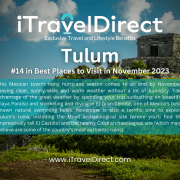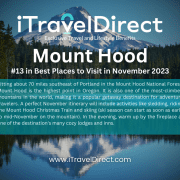Serengeti National Park #10 in Best Places to Visit in October 2023
Why Go To Serengeti National Park
“There’s more to see than can ever be seen, more to do than can ever be done.” When musicians Elton John and Tim Rice wrote the opening tune to Disney’s “The Lion King,” they were describing the “Circle of Life.” But this lyric serves as a fitting description for world-renowned Serengeti National Park. This magnificent game park sprawls across 5,700 square miles of northern Tanzania in East Africa. When American hunter-turned-conservationist Stewart Edward White first set foot in the Serengeti in 1913, he described the journey: “We walked for miles over burnt out country. … Then I saw the green trees of the river, walked two miles more and found myself in paradise.”
Within the boundaries of the Serengeti, you’ll hear thousands of animals: Hyenas cackle as elephants trample well-worn safari roads and hippos splash in watering holes. And at any given time, more than 2,000 lions are poised to pounce on unsuspecting prey, preparing to chase their unlucky target through the seemingly endless waves of golden grass. The scenery rustles with the swift steps of loping giraffes, and tree branches shake with every monkey’s movement. But the most magical site you’ll behold is The Great Migration, during which White’s paradise is drowned by a sea of animals as more than one million wildebeest, zebras and gazelles traverse the Serengeti in search of greener pastures.
Best Months to Visit
The best times to visit Serengeti National Park are from January to February or from June through September, although you should plan your trip around the movement of The Great Migration. For example, winter is the best time to see the herd in Southern Serengeti, while the Western Corridor and Northern Serengeti are the best places to spend the summer and autumn months. Most safari operators will have a good idea of where the animals are headed and when, and most will adjust their itineraries based on the herd’s movement. Temperatures remain relatively constant with daytime highs resting in the 80s. You’ll find cooler weather in the Ngorongoro Conservation Area due to its higher elevation. April and May see the most rainfall, and many lodges and camps close for this slower season.
Culture & Customs
The official currency here is the Tanzanian Shilling (TZS). One shilling equals less than one American penny, but check the latest exchange rate before you visit. Both the shilling and the U.S. dollar are generally accepted throughout the park, however, you’ll get a better deal if you pay with shillings.
To enter Serengeti National Park, travelers will be charged $25 each per day visited. If you plan on driving in the park, an additional $5 fee per day applies. Entrance fees are typically covered by safari package and travel agent rates. Once inside, tips of $5 to $10 per day are expected for safari drivers and services received at camps and lodges, while it is common practice to leave 10 percent of your total bill as a tip when dining at a lodge restaurant. ATMs are not readily available in the Serengeti, so be sure to take out money before arriving at the park.
Tourists may see the Serengeti as a natural playground, but members of the indigenous Masai ethnic group see it as home. The Masai are a semi-nomadic people found in Kenya and northern Tanzania. Their brightly colored clothing and distinctive customs – namely, their unique music and dance and intricate jewelry – make them one of Africa’s most well-known ethnic groups.
You’re sure to come across the Masai during your visit. Although their official language is Maa (a Nilo-Saharan language), most members of the Masai ethnic group also speak Swahili and English, Tanzania’s official languages. Some Swahili phrases that may come in handy are “jambo” (hello), “asante sana” (thank you), “Bei gani?” (How much?), and “sielewi” (I don’t understand). Your interaction with the Masai people will most likely be a lucrative one for them, as they are very willing to sell you their jewelry and crafts.
Safari guides speak English as well, and it’s imperative that you follow your guide’s instructions at all times. The Serengeti houses many animals, and your guide will know how to best handle (or better avoid) dangerous situations. Stay in your vehicle at all times (unless your guide gives you permission to exit) and never try to feed the animals. And to protect against the region’s rays and bugs when wildlife spotting, bring safari essentials like bug spray and sunscreen.
What to Eat
Restaurants are few and far between in Serengeti National Park, but if you want to enjoy a sit-down meal, you’re in luck – several of the park’s lodges feature one or more on-site restaurants. Serengeti Serena Safari Lodge, for example, has an eatery that specializes in buffet-style meals with traditional safari and Tanzanian fare, such as locally sourced coffee and tea, nyama choma (grilled meats) and ugali (a maize dish that has a porridge-like consistency). And at the Four Seasons Safari Lodge Serengeti, three dining venues are available, including an outdoor terrace with pizza and African-inspired tapas and an indoor buffet with various African and international dishes. Boma Grill, the property’s third restaurant, seats guests around an open-air fire pit as they savor African dishes and watch the Masai perform a traditional dance. Many Serengeti lodges will also offer bush dining experiences, where diners can enjoy a private meal in the wild.
However, most travelers opt to go on safari (most of which cover all meals in tour rates) or purchase food at one of the park’s convenience stores to prepare at a campsite. Safari tour operators that provide meals at a lodge or boxed to enjoy picnic-style include Africa Dream Safaris and Serengeti Select Safaris. Keep in mind that some companies charge an additional fee for soft drinks and alcoholic beverages. For budget-conscious travelers, the park sells drinks, snacks and raw meat for grilling at convenience stores in the Seronera River Valley and Naabi Hill.
Getting Around Serengeti National Park
The best way to get around Serengeti National Park is by safari. Safari guides know how to best navigate the park’s dirt roads and how to find the most fascinating wildlife. Many safari packages also cover transportation to and from the airstrips, food and lodging. If you prefer to travel on your own, you can rent a car (and even hire a driver) at Kilimanjaro International Airport (JRO), which is located about 190 miles east of the park’s main entrance, Naabi Hill Gate. Additionally, all five regions of the Serengeti – Northern Serengeti, the Western Corridor, Eastern Serengeti, Central Serengeti and Southern Serengeti – are accessible by air through several regional carriers and nine internal airstrips.
Safari
To make the most of your visit to Serengeti National Park, consider booking a safari tour. Knowledgeable guides can provide a wealth of information on the park’s regions and wildlife. Some tour operators offer a variety of ways to get around, including hiking and driving. You can even see a bird’s-eye view of the park on a hot air balloon safari. To save money, consider booking a safari package, which are offered by companies like African Dream Safaris and Serengeti Select Safaris and include transportation, lodging and food.
African Dream SafarisSerengeti Select Safaris
CarYou are welcome to explore Serengeti National Park by car, but it’s not recommended. While the roads are well traveled, they’re not always clearly marked, which can make finding your way difficult. Drivers are required to pay an extra $5 fee every day per vehicle. Also, the park is relatively devoid of fuel stations, so unless you are familiar with the area, you may find yourself in a sticky situation. You can rent a car at Kilimanjaro International Airport.
Plane
Though the only options for getting around the park are to travel by safari tour or car, visitors can get to and from Serengeti National Park by plane. There are nine airstrips found inside the park. The Seronera airstrip serves Central Serengeti; the Lobo, Kleins and Kogatende airstrips provide access to the north; the Grumeti, Kirawira and Sasakwa airstrips offer service to the Western Corridor; and the Kusini and Ndutu airstrips are situated in Southern Serengeti. Regional Air Services, Air Excel and Auric Air Services operate daily flights to several of the park’s airstrips from Arusha – a bustling city near Kilimanjaro International Airport. Round-trip flights generally cost between $396 and $435 per person.
Entry & Exit Requirements
To enter Tanzania, U.S. citizens must have a valid passport and visitor’s visa. Passports must include at least one blank visa page and be valid for a minimum of six months past your arrival date. Visas cost $100 and can be obtained either before your trip at a Tanzanian consulate or upon arrival at any point of entry staffed by immigration officials. Before traveling to the region, the Centers for Disease Control and Prevention recommends receiving vaccinations for hepatitis A and B, rabies and typhoid on top of regular vaccines like polio and measles. Due to the prevalence of mosquitos in the Serengeti, some doctors may also prescribe anti-malarial medication to take before, during and after your trip. And travelers who do not have direct flights from the U.S. or Europe will need to obtain a yellow fever vaccination and present their proof of vaccination when they arrive. For more information about visas and vaccines, visit the U.S. State Department’s website and the CDC’s website.
Start Saving with iTravelDirect’s Exclusive Travel and Lifestyle Benefits Membership
CLICK HERE to Test-Drive our Guaranteed Savings
We offer a 110% Price Guarantee – Find a lower price anywhere online and we will refund you 110% of the difference.
CLICK HERE for a full list of services and Membership Discounts.
When you join iTravelDirect, you’ll have full access to all club benefits.
Your membership gives you the freedom to travel when you want, to where you want.
And you won’t find lower rates anywhere, guaranteed. So, pack your bags and start planning that vacation of a lifetime today!












Leave a Reply
Want to join the discussion?Feel free to contribute!